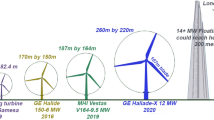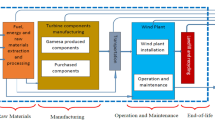Abstract
Background, aim and scope
Renewable energy sources nowadays constitute an increasingly important issue in our society, basically because of the need for alternative sources of energy to fossil fuels that are free of CO2 emissions and pollution and also because of other problems such as the diminution of the reserves of these fossil fuels, their increasing prices and the economic dependence of non-producers countries on those that produce fossil fuels. One of the renewable energy sources that has experienced a bigger growth over the last years is wind power, with the introduction of new wind farms all over the world and the new advances in wind power technology. Wind power produces electrical energy from the kinetic energy of the wind without producing any pollution or emissions during the conversion process. Although wind power does not produce pollution or emissions during operation, it should be considered that there is an environmental impact due to the manufacturing process of the wind turbine and the disposal process at the end of the wind turbine life cycle, and this environmental impact should be quantified in order to compare the effects of the production of energy and to analyse the possibilities of improvement of the process from that point of view. Thus, the aim of this study is to analyse the environmental impact of wind energy technology, considering the whole life cycle of the wind power system, by means of the application of the ISO 14040 standard [ISO (1998) ISO 14040. Environmental management—life cycle assessment—principles and framework. International Standard Organization, Geneva, Switzerland], which allows quantification of the overall impact of a wind turbine and each of its component parts using a Life Cycle Assessment (LCA) study.
Materials and methods
The procedures, details, and results obtained are based on the application of the existing international standards of LCA. In addition, environmental details and indications of materials and energy consumption provided by the various companies related to the production of the component parts are certified by the application of the environmental management system ISO 14001 [ISO (2004) ISO 14001 Environmental management systems—requirements with guidance for use. International Standard Organization, Geneva, Switzerland]. A wind turbine is analysed during all the phases of its life cycle, from cradle to grave, by applying this methodology, taking into account all the processes related to the wind turbine: the production of its main components (through the incorporation of cut-off criteria), the transport to the wind farm, the subsequent installation, the start-up, the maintenance and the final dismantling and stripping down into waste materials and their treatment. The study has been developed in accordance with the ISO 14044 standard [ISO (2006) ISO 14044: Environmental management—life cycle assessment—requirements and guidelines. International Standard Organization, Geneva, Switzerland] currently in force.
Results
The application of LCA, according to the corresponding international standards, has made it possible to determine and quantify the environmental impact associated with a wind turbine. On the basis of this data, the final environmental effect of the wind turbine after a lifespan of 20 years and its subsequent decommissioning have been studied. The environmental advantages of the generation of electricity using wind energy, that is, the reduction in emissions and contamination due to the use of a clean energy source, have also been evaluated.
Discussion
This study concludes that the environmental pollution resulting from all the phases of the wind turbine (manufacture, start-up, use, and dismantling) during the whole of its lifetime is recovered in less than 1 year.
Conclusions
From the developed LCA model, the important levels of contamination of certain materials can be obtained, for instance, the prepreg (a composite made by a mixture of epoxy resin and fibreglass). Furthermore, it has been concluded that it is possible to reduce the environmental effects of manufacturing and recycling processes of wind turbines and their components.
Recommendations and perspectives
In order to achieve this goal in a fast and effective way, it is essential to enlist the cooperation of the different manufacturers.



Similar content being viewed by others
References
Ardente F, Beccali M, Cellura M, Lo Brano V (2008) Energy performances and life cycle assessment of an Italian wind farm. Renew Sustain Energ Rev 12(1):200–217
Banister D, Stead D, Steen P, Åkerman J, Dreborg K, Nijkamp P, Schleicher-Tappeser R (2000) European transport policy and sustainable mobility. Spon, Suffolk, p 255
Bauman H, Tillman A-M (2004) The hitch hiker’s guide to LCA. Studentlitteratur AB, Sweden
Ben Amar F, Elamouri M, Dhifaoui R (2008) Energy assessment of the first wind farm section of Sidi Daoud, Tunisia. Renew Energ 33(10):2311–2321
Boustead I, Hancock GF (2003) Handbook of industrial energy analysis. In: Frischknecht R, Jungbluth N (eds) Implementation of life cycle assessment methods. ecoinvent report no. 3. Swiss Centre for Life Cycle Inventories, Dübendorf, pp 22–28
Breukers S, Wolsink M (2007) Wind power implementation in changing institutional landscapes: an international comparison. Energ Policy 35(5):2737–2750
Carolin Mabel M, Fernandez E (2008) Growth and future trends of wind energy in India. Renew Sustain Energ Rev 12(6):1745–1757
Celik AN, Muneer T, Clarke P (2007) An investigation into micro wind energy systems for their utilization in urban areas and their life cycle assessment. Proc Automob Div Inst Mech Eng A J Power Energ 221(8):1107–1117
Cunliffe AM, Jones N, Williams PT (2003) Pyrolysis of composite plastic waste. Environ Technol 24:653–663
del Río P, Unruh G (2007) Overcoming the lock-out of renewable energy technologies in Spain: The cases of wind and solar electricity. Renew Sustain Energ Rev 11(7):1498–1513
de Marco I et al (1997) Recycling of the products obtained in the pyrolysis of fibre-glass polyester SMC. J Chem Tech Biotechnol 69:187–192
Douglas CA, Harrison GP, Chick JP (2008) Life cycle assessment of the Seagen marine current turbine. Proc Automob Div Inst Mech Eng M J Eng Marit Environ 222(1):1–12
Dutra RM, Szklo AS (2008) Incentive policies for promoting wind power production in Brazil: scenarios for the alternative energy sources incentive program (PROINFA) under the new Brazilian electric power sector regulation. Renew Energ 33(1):65–76
Elamouri M, Ben Amar F (2008) Wind energy potential in Tunisia. Renew Energ 33(4):758–768
Etxeberria M, Vázquez E, Marí A, Barra M (2007) Influence of amount of recycled coarse aggregates and production process on properties of recycled aggregate concrete. Cement Concrete Res 37(5):735–742
Frischknecht R, Rebitzer G (2005) The ecoinvent database system: a comprehensive web-based LCA database. J Clean Prod 13(13–14):1337–1343
Frischknecht R, Jungbluth N, Althaus H-J, Doka G, Dones R, Heck T et al (2005) The ecoinvent database: Overview and methodological framework. Int J Life Cycle Assess 10(1):3–9
GER (2004) Proyecto de desmantelamiento del parque eólico de Munilla—Lasanta.
Goedkoop M, Oele M, Effting S (2004) SimaPro database manual methods library. PRé Consultants, Netherlands
Góralczyk M (2003) Life-cycle assessment in the renewable energy sector. Appl Energ 75(3–4):205–211
Guinée JB, Gorree M, Heijungs R, Huppes G, Kleijn R, van Oers L, Wegener Sleeswijk A, Suh S, Udo de Haes HA, de Bruijn JA, van Duin R, Huijbregts MAJ (2001) Life cycle assessment: an operational guide to the ISO standards. Kluwer, Amsterdam
Gurzenich D, Mathur J, Bansal NK, Wagner H-J (1999) Cumulative energy demand for selected renewable energy technologies. Int J Life Cycle Asses 4(3):143–149
GWEC Global Wind Energy Council (2005) Wind Force 12. A blueprint to achieve 12% of the world’s electricity from wind power by 2020
Hauschild M, Wenzel H (1998) Environmental assessment of products, scientific background, vol. 2. Chapman & Hall, UK
ISO (1998) ISO 14040. Environmental management—life cycle assessment—principles and framework. International Standard Organization, Geneva
ISO (2004) ISO 14001 Environmental management systems—requirements with guidance for use. International Standard Organization, Geneva
ISO (2006) ISO 14044: Environmental management—life cycle assessment—requirements and guidelines. International Standard Organization, Geneva
Jäger-Waldau A (2007) Photovoltaics and renewable energies in Europe. Renew Sustain Energ Rev 11(7):1414–1437
Jungbluth N, Bauer C, Dones R, Frischknecht R (2005) Life cycle assessment for emerging technologies: case studies for photovoltaic and wind power. Int J Life Cycle Assess 10(1):24–34
Karki R (2007) Renewable energy credit driven wind power growth for system reliability. Electr Pow Syst Res 77(7):797–803
Khan FI, Hawboldt K, Iqbal MT (2005) Life cycle analysis of wind–fuel cell integrated system. Renew Energ 30(2):157–77
Lunt D, Zhuang Y, La Brooy S (2002) Life cycle assessment of process options for copper production. Green Processing 2002—Proceedings: International Conference on the Sustainable Processing of Minerals, pp 185–193
Marchenko OV (2008) Modeling of a green certificate market. Renew Energ 33(8):1953–1958
Mila i Canals L, Domenech X, Rieradevall J, Puig R, Fullana P (2002) Use of life cycle assessment in the procedure for the establishment of environmental criteria in the Catalan eco-label of leather. Int J Life Cycle Assess 7(1):39–46
Muñoz I, Rieradevall J, Domenech X, Gazulla C (2006) Using LCA to assess eco-design in the automotive sector: case study of a polyolefinic door panel. Int J Life Cycle Assess 11(5):323–334
Norgate TE, Rankin WJ (2000) Life cycle assessment of copper and nickel production. Proceedings of MINPREX 2000. The Australian Institute of Mining and Metallurgy, Melbourne, pp 133–138
Norgate TE, Jahanshahi S, Rankin WJ (2007) Assessing the environmental impact of metal production processes. J Clean Prod 15(8–9):838–848
Papadopoulos AM, Glinou GL, Papachristos D (2008) Developments in the utilisation of wind energy in Greece. Renew Energ 33(1):105–110
Pehnt M (2006) Dynamic life cycle assessment (LCA) of renewable energy technologies. Renew Energ 31(1):55–71
Perrin D et al (2006) SMC composites waste management as reinforcing fillers in polypropylene by combination of mechanical and chemical recycling processes. J Mater Sci 41(12):3593–3602
Pickering SJ (2006) Recycling technologies for thermoset composite materials—current status. Composites A 37:1206–1215
Pimentel D (2003) Food production and energy crisis. In: Frischknecht R, Jungbluth N (eds) Implementation of life cycle assessment methods. ecoinvent report no. 3. Swiss Centre for Life Cycle Inventories, Dübendorf, pp 22–28
Rieradevall J, Domenech X, Fullana P (1997) Application of life cycle assessment to landfilling. Int J Life Cycle Assess 2(3):141–144
Sailor DJ, Smith M, Hart M (2008) Climate change implications for wind power resources in the Northwest United States. Renew Energ 33:2393–2406
SimaPro 7 (2006) Ecoinvent data base. PRé Consultants, Amersfoort, Netherlands
Spielmann M, Scholz RW (2005) Life cycle inventories of transport services: background data for freight transport. Int J Life Cycle Assess 10(1):85–94
Torres A et al (2000) Recycling by pyrolysis of thermoset composites: characteristics of the liquid and gaseous fuels obtained. Fuel 79:897–902
Troen I, Petersem EL (1991) European wind atlas. Risø National Laboratory, Roskilde, Denmark, p. 656, ISBN 87-550-1482-8
Tryfonidou R, Wagner H-J (2004) Multi-megawatt wind turbines for offshore use: aspects of life cycle assessment. Int J Global Energy 21(3):255–262
Vallee M, Tersac G, Destais-Orvoen N, Durand G (2004) Chemical tecycling of class A surface quality sheet-molding composites. Ind Eng Chem Res 43(20):6317–6324
Wichser C, Klink K (2008) Low wind speed turbines and wind power potential in Minnesota, USA. Renew Energ 33(8):1749–1758
Williams PT, Cunliffe A, Jones N (2005) Recovery of value-added products from the pyrolytic recycling of glass fibre-reinforced composite plastic waste. J Energy Inst 78(2):51–61
Young S, Dubreuil A, Stewart N (2006) Qualitative maps of metal recycling. Draft Report prepared for the International Council on Mining & Metals, London, UK
Yuksel I (2008) Global warming and renewable energy sources for sustainable development in Turkey. Renew Energ 33(4):802–812
Author information
Authors and Affiliations
Corresponding author
Additional information
Responsible editor: Niels Jungbluth
Rights and permissions
About this article
Cite this article
Martínez, E., Sanz, F., Pellegrini, S. et al. Life-cycle assessment of a 2-MW rated power wind turbine: CML method. Int J Life Cycle Assess 14, 52–63 (2009). https://doi.org/10.1007/s11367-008-0033-9
Received:
Accepted:
Published:
Issue Date:
DOI: https://doi.org/10.1007/s11367-008-0033-9




